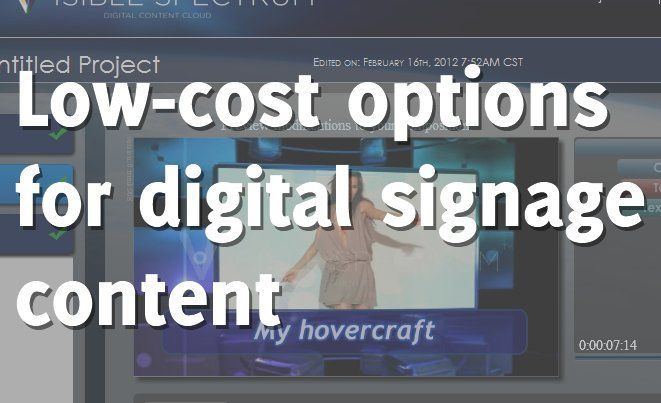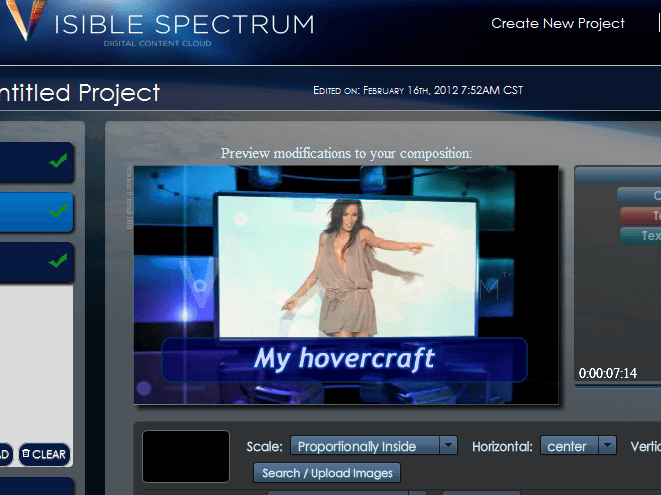
Four Low-Cost Options For Digital Signage Creative
February 16, 2012 by Dave Haynes
If you want really great, visually compelling and impactful creative for your digital signage network, you’re going to pay handsomely for it because talent has a price. But new online tools are emerging that can seriously cut costs on some of the advertising and marketing creative that will never have much in the way of creative direction or budgets.
Templated layouts have been built into some of the content management platforms for a bunch of years, with guys like FirmChannel being particularly strong at that. But now we’re seeing third-party services that allow network operators to choose designs, populate them with images and messages, and spit out ad spots at a fraction of the cost of creative production shops.
It’s stuff that won’t likely win any awards, but still has a professional sheen to it. It’s a supplement to proper creative, but by no means a replacement for original thinking and dedicated, focused design.
Here are some examples of services that might get used if the budget just isn’t there to hire creative pros.
Visible Spectrum – This is a Chicago-area company that has a fully online tool that allows users to create accounts and then select from templates and stock images/videos to build full motion graphics ads.
I looked at a demo account a few weeks ago and kinda sorta liked what I saw, but also thought it needed a lot of work. I was told that was underway and coming soon, and yesterday I got an email saying the new version was out.
In this new version, users can search VSI’s cloud of 17.4 million images and videos, seamlessly add any image or video simply by dragging to and from the cloud search page to their clipboard, add custom text and other elements at the keyboard, and preview their compositions in real-time before buying.
John Malec, VSI’s CEO, stated: “Version 1.3 is a real jump forward. It is difficult both powering up a tool’s functionality while simultaneously making it easier and more intuitive to use. With version 1.3 we’ve done just that.”
High on the list of improvements in version 1.3 is the new clipboard which remains visible throughout the composition process. Users can load the clipboard with images and videos dragged from VSI’s cloud search results to the clipboard, or upload them from their computer. When evaluating different creative treatments, the user can drag any thumbnail from the clipboard directly into a composition. Alternatives may be viewed in context of the composition and many treatments evaluated without the user incurring any fee. Only when the user is satisfied with the final result is the composition purchased – at a low cost usually between $125 and $250.
VSI templates are not the flat two dimensional templates common to digital signage. Rather, they can include state-of-the-art “2.5D motion” making them the equal of more elaborate television or blockbuster movie creations.
It’s pretty slick, though I would agree it is “more intuitive” but not entirely intuitive.
People who know me well will know I have had something like this plotted out for several years … but life and a need to pay the bills instead of create more of them kept it from getting too far along. This is in the vicinity of what I think really works for this sector — polished-looking spots at a fraction of the cost of even basic creative work from most production shops who operate in this space.
I like that you can select from a large stock image gallery, though my guess is that is a big part of how the platform makes its money – margin on images and video.
Screen Guru – The guys from Met Hodder were telling me about this last year at DSE, but frankly by the tail end of that trade show telling me anything is an in-one-ear-out-the-other thing. Too much information in too short a time.
But I was reminded recently about this project and had a look. The long-time content house, based in Minneapolis, has taken a very different approach from the guys to their east. The Screen Guru is a third-party template gallery that clients get at and use via the web , but the difference is the creative pros at the agency custom design the foundational templates and users just tweak them from there.
ScreenGuru is a platform-independent and easy-to-use content creation solution for digital signage. It allows anyone – from novices to sophisticated content producers – to create dynamic messages using customized templates in a secure enterprise environment. It was developed by Met|Hodder, a leader in content strategy, creation and management for digital signage, television, online and mobile platforms.
ScreenGuru features:
- Secure, hosted content creation platform
- Original design templates built to client needs
- Ability to edit or select text, imagery and other message elements
- Intuitive WYSIWYG interface
- Flexible permission settings for content creators, reviewers and approvals
- Compatible with all digital signage software platforms
I’ve not tested the service, and I’d imagine pricing is a little dependent on how much work goes into the templates. I do like the user experience look more than Visible – at least at first glance. It just seems more aligned with the Web 2.0 services I generally see and use.
Animoto – This is not a pure-play digital signage service, at all. But I absolutely know companies are using it to produce low-cost ads and messaging spots.
The company has been around for a few years and primarily offers the ability for users to create accounts, select motion graphic templates, and upload photos and background music tracks to auto-generate some very slick looking video presentations. I used Animoto to create a beautiful photo memorial when my Mom passed away several months ago. It took way longer to sort and scan images than it did to process a beautiful four-minute tribute.
Animoto, says the NYC-based company, automatically produces beautifully orchestrated, completely unique video pieces from your photos, video clips, and music.
It takes a little experience and tweaking to get the timing down, but for $250/year, a company can knock out an unlimited number of unbranded video spots. It’s important to remember they will all start to look the same quickly, but at that price point, the account would pay for itself very, very quickly.
Stupeflix – There are a few companies doing things similar to Animoto, but the one I like is Stupeflix from France. It works very muich like Animoto – and like its rival is dead easy to use. The price points are also very similar. For not very much at all, users can bang out unbranded 720P HD videos based on images and simple calls to action.
The company has a commercial API that would some enterprising firm (with the help of a wink-wink smart consultant) to set up a white-labeled service.
Video is the only format that works well across all connected devices: computers, smartphones, tablets, TV sets. While video is in high demand, it is still expensive to produce. “We have seen an increase of inquiries from developers all over the world who need to create videos automatically. We changed our business model, and lowered our prices, to give our customers the value and flexibility they need,” explains Francois Lagunas, Stupeflix co-founder and CTO. Now developers can use the Stupeflix API commercially for as low as $300 a month. Customers only pay for what they use, with prices as low as $0.20 per minute of video rendered.
There are other services like that, and I am not doubt missing creative tools focused like Visible Spectrum and Screen Guru on this space that aren’t inside CMS platforms. Let me know.







Congratulations Dave on truly useful article for our industry. And may I recommend the readers to consider IAdea media appliances (http://www.IAdea.com/product) to go with these services as the IAdea devices produce premium quality video playback at amazingly low price.